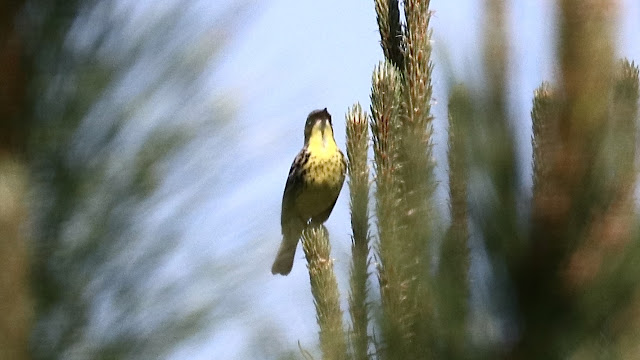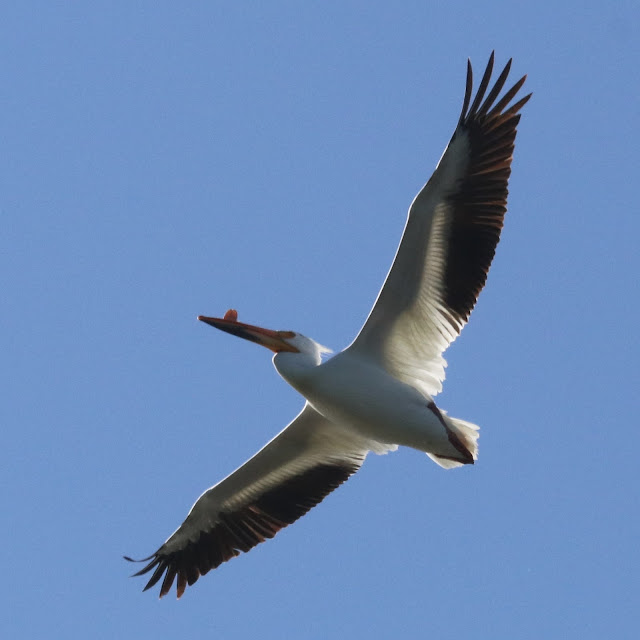From the beginning of my Canada Big Year, setting a record for species count was not my top priority. Yes, I want to see most of the birds that make Canada home, but more importantly, I wanted to see most of the country that is my home, birding in the ten provinces and both major territories. Thus, my trip to the Northwest Territories was more about being there than seeing the target bird. Of course, I did come for the Whooping Cranes too, at Wood Buffalo National Park. It stretches into Alberta and though I flew to Yellowknife and drove eight and a half hours to Fort Smith, my eBird list shows that the Whooping Cranes,(Spoiler Alert), were in Alberta when I saw them. Alas, they were about as far away as they could be and still be visible. The photos I took through my Vortex spotting scope, looked more like big white blobs than big white wading birds. Whoops!
Once numbering over 10,000 individuals, the Whooping Crane has been the focus of conservation projects both in Canada and the US. As recently as the 1940’s the Whooping Crane was heading toward extinction, with only 21 of them remaining in the wild, due mostly, of course, to hunting. In the early 1960’s the Whooping Crane Conservation Association was established to help bring back the population and avoid the extinction of North America’s largest bird. By the 1970’s the population had increased to 60 birds, which have gone on to produce the present population of about 500.
My trip began with a flight to Yellowknife, via Edmonton and picking up my rental car that I had reserved months in advance, knowing that rental cars are hard to come by both here, in the Yukon, and as previously noted, in Edmonton. By the way, the NWT has the best license plates:
My first discovery was that Tennessee Warblers are everywhere up here. It is the most common of the breeding songbirds as far as I could hear. I was also surprised to see a pair of Lesser Yellowlegs perched atop the Spruce trees. Not exactly acting as a shore bird, here. Perhaps they were watching the nest from the high ground.
The next morning, I was up at 2am for the nearly 9 hour drive to Fort Smith and Wood Buffalo National Park. Unlike the Yukon, which is mountainous, the Northwest Territories are mostly flat and covered in boulders left over from the ice age, called glacial erratics, not to be confused the Sherlock Holmes, Baker Street Irregulars. These giant rocks were carried over long distances by the movement of glacial ice and now make up a huge portion of the landscape here, including, sometimes, part of the construction of homes and buildings. And they are fun to hike over.
Being mostly flat, the landscape was so smooth and straight that I didn’t feel like I was on the road for most of the day, as I drove down to Fort Smith. Yes, I could have driven north from Edmonton, but what fun would that have been? I’d still have wanted to visit Yellowknife. I’m glad I did it this way. The biggest issue with the drive, and I might say, most of the fun, was being stopped along the way by roving bands of wild Bison. You really need to keep your eyes on the road while driving through the Mackenzie Bison Sanctuary. These large bovines, often referred to as buffalo in North America, will cross the highway at their leisure, as they graze the fields in the mornings. Oh, and the spots in front of the windshield are giant black flies.
I arrived around noon in Fort Smith, with a stop in Hay River for the essentials, gas, coffee, a bagel and “comfort stop.” Fort Smith is your typical one horse town of the old west, with a few hotels, one restaurant and a gas station. I also discovered that Wood Buffalo National Park is not a traditional NP in that there is no entrance, as would be the case at, say, Point Pelee. Instead, like the numerous territorial parks in the Northwest Territories, it is a series of pull outs and trails and protected areas open to all who care to drive through and explore. I did need a map, however, to help me locate and get to the best viewing locations for the Whooping Cranes, the targets of my affection and my reason for being here. With some help from the gas station attendants, I was directed toward the National Park Visitor Centre and was given a map with various locations the cranes, both Whooping and Sandhill, could be viewed, but told not to get my hopes up and that the odds of actually seeing them at this time of year were low, as they spend most of their time hidden on their nests. I guess I didn’t plan this very well. Whoops!
However, I was game to try and followed the map to various hot spots and began hiking. Without bear spray. Whoops! I forgot bear spray. So I turned heal and quickly hiked back to my car, keeping my eye out for the parent of the baby bear I had seen walking along the side of the road, and scampered over to the closest Home Hardware for bear repellent and additional bug spray to deal with the mosquitoes and black flies. One thing you can count on in Canada, is every small town will have a Home Hardware, even if they lack the ubiquitous Tim Hortons, which was the case in Fort Smith.
Armed with my protective kit, I sprayed on copious amounts of Deep Woods Off, to keep the mosquitoes at bay and the black flies, the size of Volkswagens, off my head. They swarm everywhere and rush at you as soon as you open the car door. One saving grace is that they do not stay in the car and most are actually anxious to get out.
I spent much of the afternoon driving from trial to trail, not having any reason to whoop it up, yet. I was given a tease when large white birds with black under their wings flew overhead. I pulled over to the side of the road, which posses no real danger up here, when the odds of seeing another car are almost as rare as the Whooping Cranes themselves. I took some quick photos and then got my binoculars on what turned out to be American White Pelicans. Whoops, again.
By about 5:30 in the afternoon I had finally arrived at the Salt Plains, the last stop on my list of Whooping Crane viewing locations. About 20 minutes from downtown Fort Smith,(if you can call it a downtown, with the one restaurant, gas station and Home Hardware), is a dirt road. About 5 miles down that gravel and rut studded road is a parking spot and viewing platform, with a trail that leads down to the salt dome,(more on that later). I set up my scope on the platform and after scanning close with my binoculars, began scoping out the distant areas of water. There, in the far distance, were two large, white wading birds, exactly where the park ranger said they might be, with the warning that I was quite unlikely to see them, of course.
But, they do have to come out to eat and drink and that is exactly what I was witnessing thorough my fully zoomed Vortex spotting scope. It was finally time to whoop with joy. But once again, as was the case with the Wood Stork, there was no one to share the joy with. I could see them well, but the resulting digiscoped photos just showed white blobs. One did flap its wings enough for me to see the black wing-tips, so I knew I had my bird. The very bird I had flown to the Northwest Territories and driven 9 hours to see, and it turned out that, while the main road is in the NWT, the viewing platform and the birds themselves are in Alberta. It was species 380 for the year and 441 for my Canada Life List, but wouldn’t show up on my NWT list. By then I was tired, exhausted really, as I had began driving at 2am that morning and I needed to check into my hotel and get some dinner. I ate in the bar at the Pelican Inn restaurant, where the delectable wings were the special and the Strongbow hard cider was a delicious bonus. With my belly full, I didn’t even have desert, I went right to bed. The steak dinner would have to wait for the next night.
The next morning I drove out to the Salt Plains again, hoping that the whoopers might be grazing a bit closer, but they were nowhere to be seen. So I hiked down to the salt dome and did the traditional taste test. You dampen the end of a finger, touch it to what looks like dried mud, and touch your finger to your tongue. Tastes like salt. But you knew it would, so it wasn’t a huge surprise.
Birding at The Battle of Crait:
I was now armed with my bear spray so spent most of the day hiking through the woods, hoping to see a grouse of some description, eventually returning to the Salt Plains to see if the Whooping Cranes came out to feed at the same time each evening.
Yes, they do. This time they were a wee bit closer, and on the grass instead of in the water. And there weren’t just two. In total I counted 5 of them. I tried some digiscope photos again, but with the heat haze and distance, those didn’t turn out with much of anything identifiable. So I shot some photos with my 400mm zoom lens and cropped them to give me at least some record shots of the birds. I’m glad I already had nice photos of Whooping Cranes from Texas, as seen at the top of this post.
I spent the rest the trip either driving back to Yellowknife, or birding around Yellowknife. The last full day was not without its drama and excitement, though. I went back to the oddly named Rat Lake and did some walking and birding around there. The birding was fine. In fact it gave me a cool, OMG moment when I spotted the cutest little baby Bonaparte’s Gulls. A secondary reason for coming way up here was to see some of the nesting sites and baby birds.
The walking turned out to be a different story. I hadn’t known until after I was attacked, that Bonaparte’s Gulls are smallest North American gull and the only one that nests in trees. Their name is not directly related to Napoleon, because of his small stature,(though it may have been a happy accident), but after his nephew, Charles Lucien Bonaparte, an ornithologist who lived in America and Europe in the 1800’s. After I took the photo of the baby gulls, I moved away from the water and began my hike around the lake. That’s when the assaults began. I became the victim of aerial attacks and bombings by Bonaparte’s Gull parents. But I was nowhere near the water. So, I pulled out my phone and did some quick internet searches to discover they are tree nesters and I must have been walking too close to the nests. As I learned, don’t mess Bonaparte’s Gulls. They come right at your head and unload their poop in vicious bombing runs. For me, it was my Waterloo.


































































